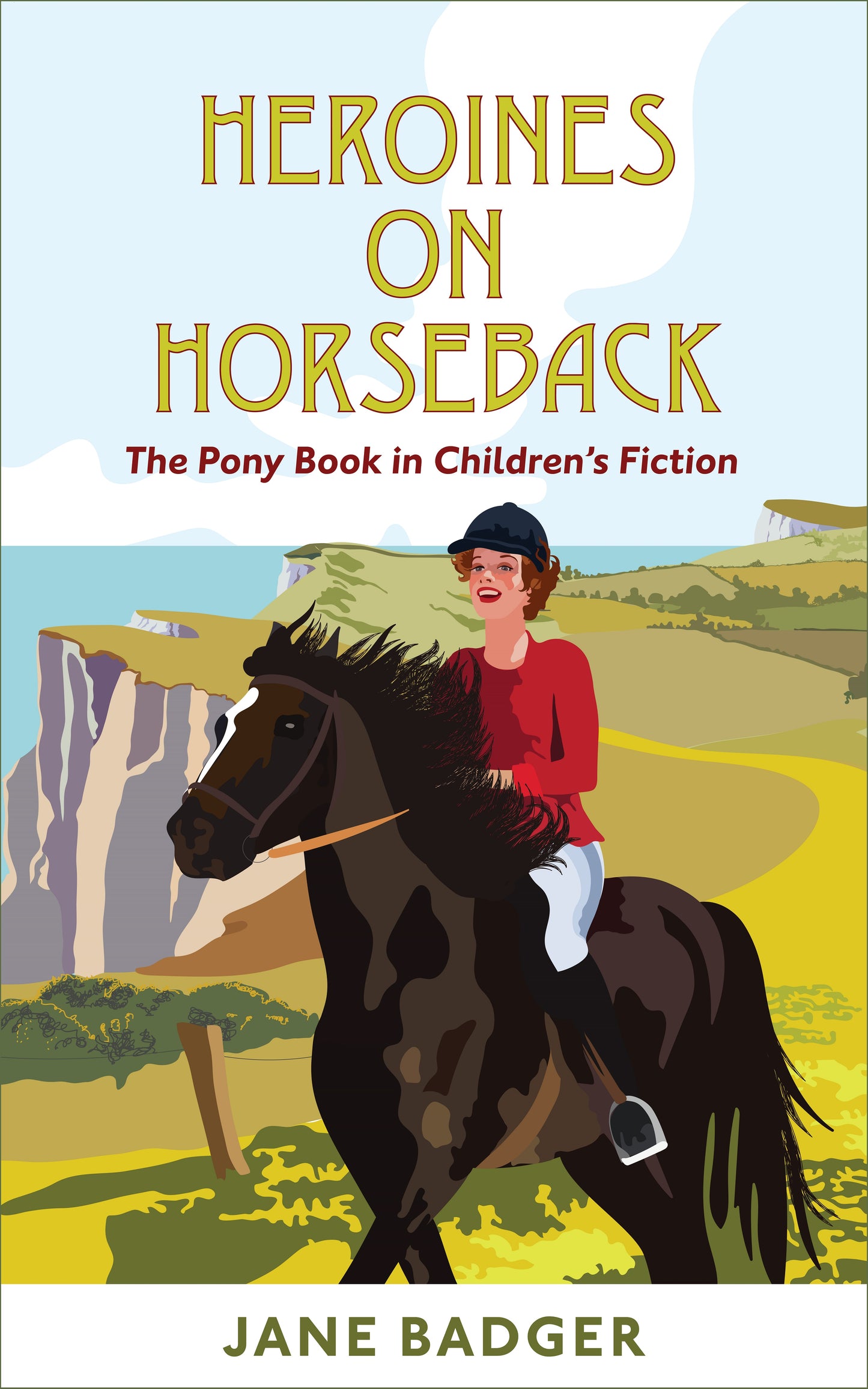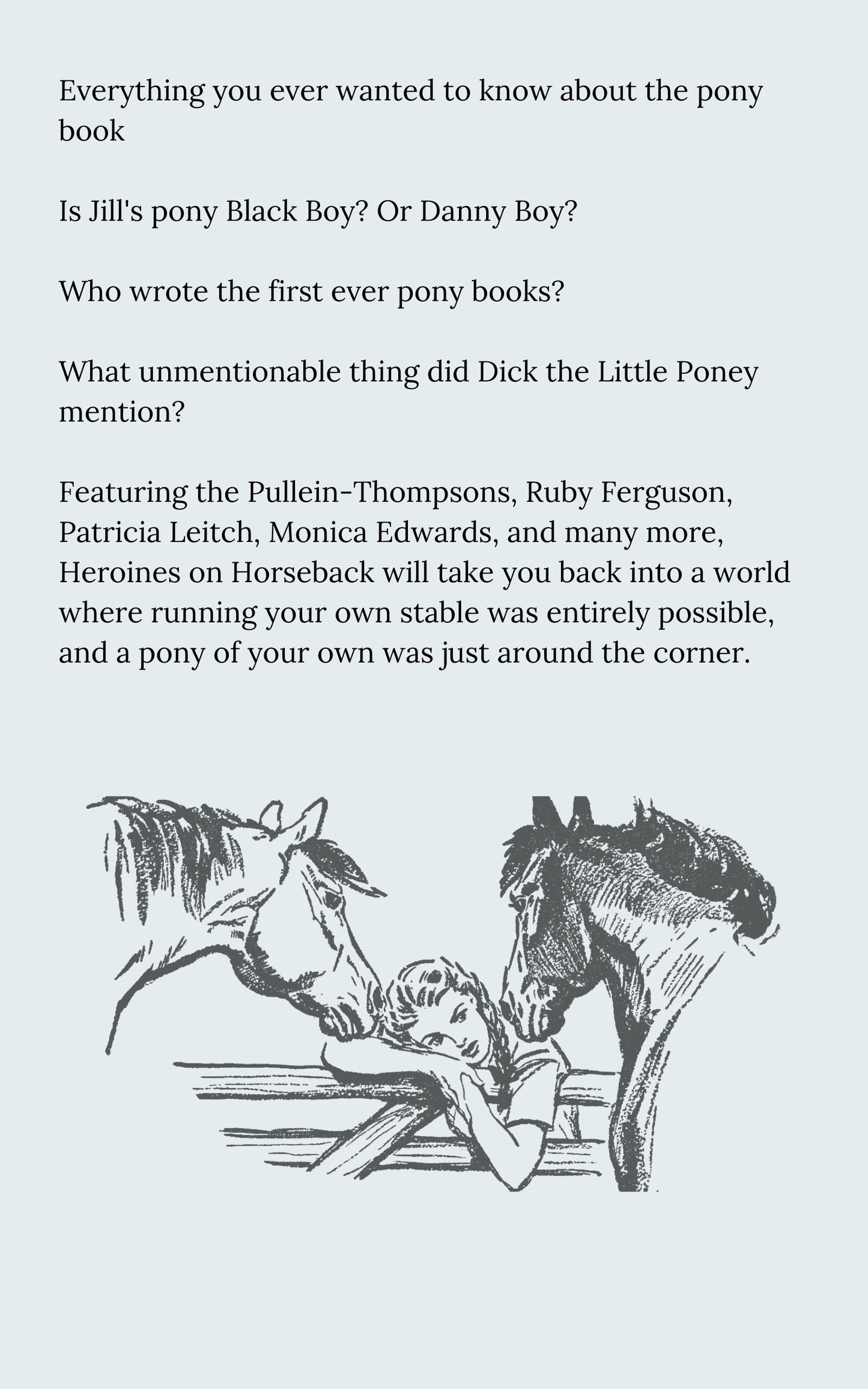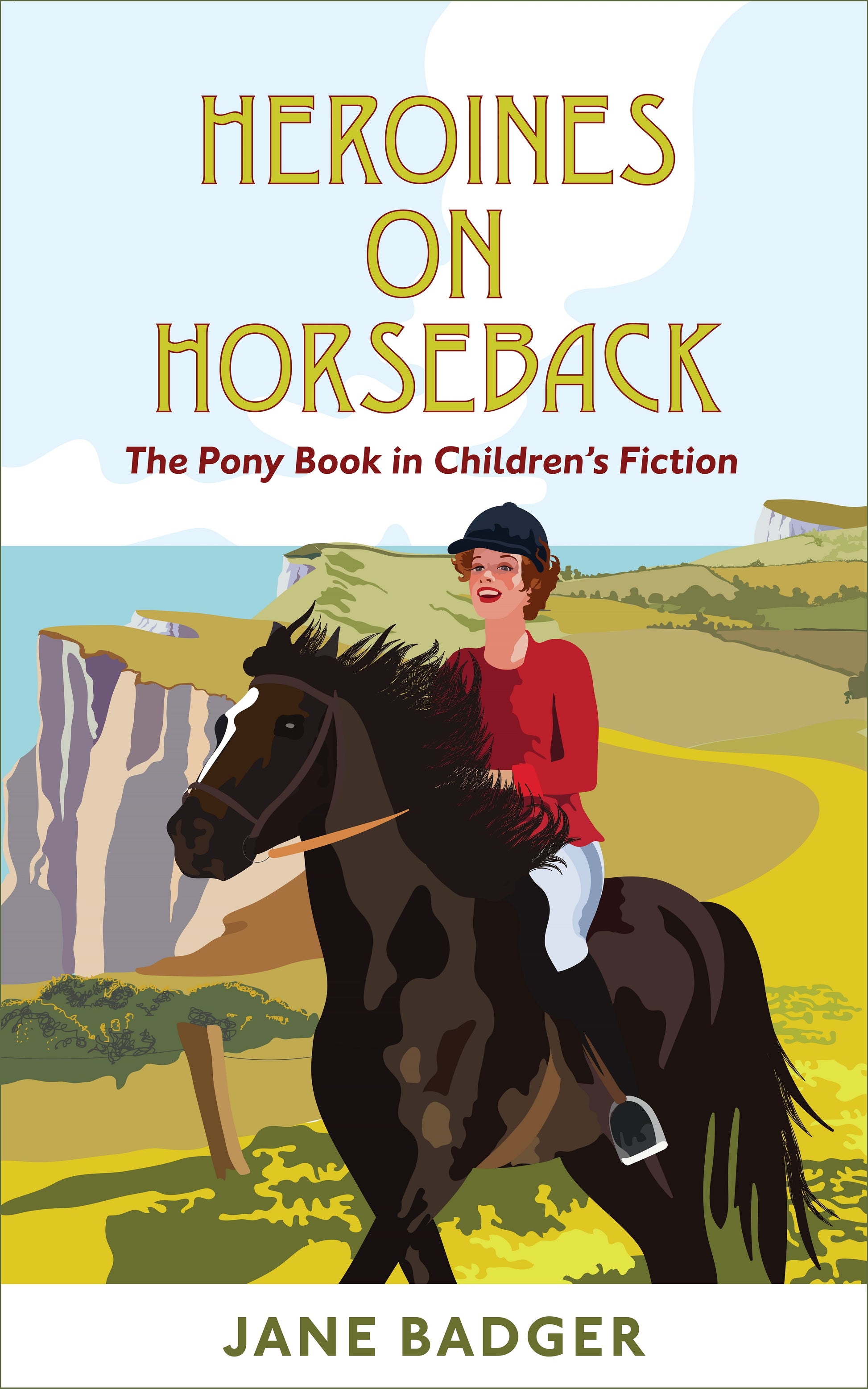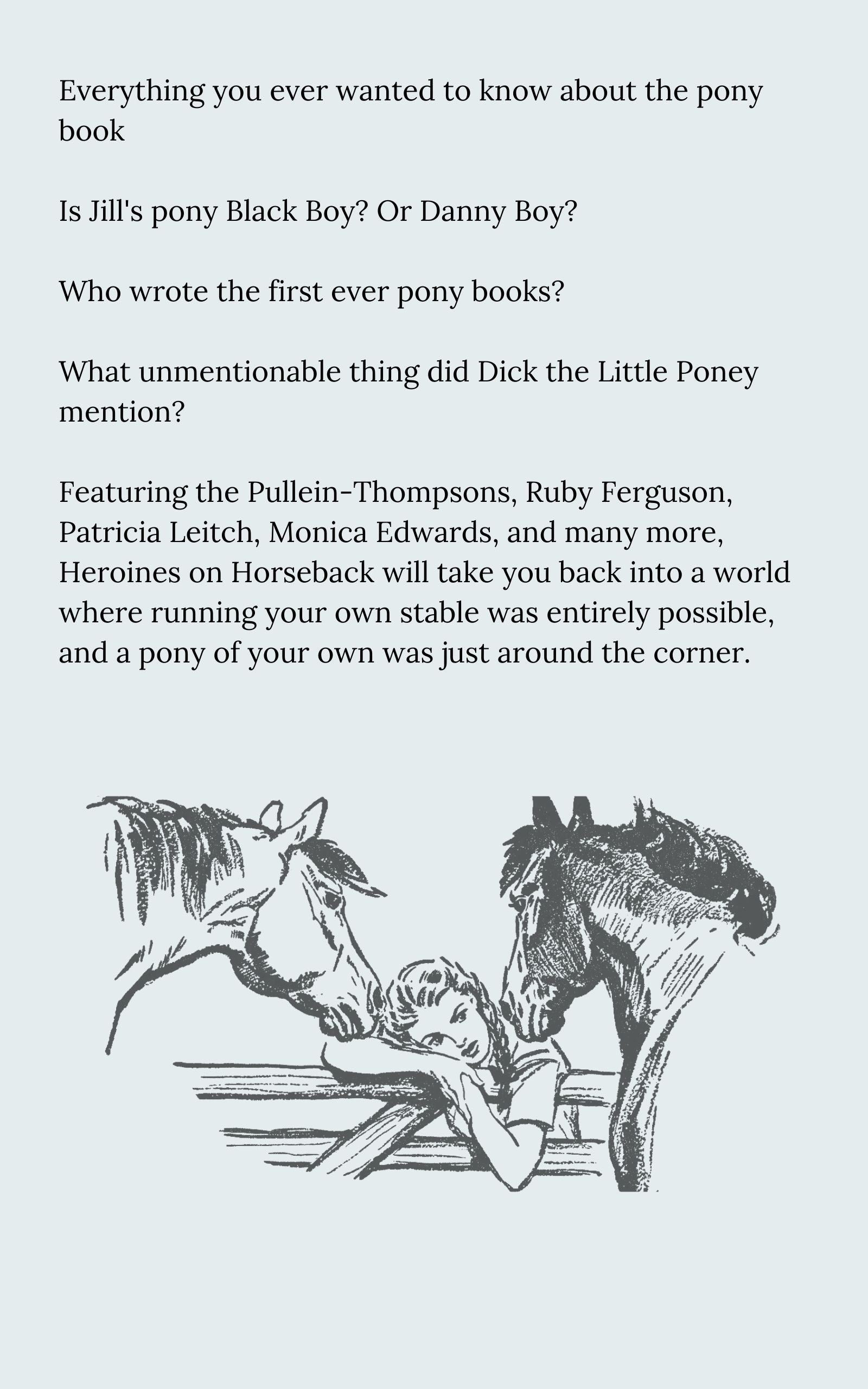Jane Badger Books
Jane Badger: Heroines on Horseback (eBook)
Jane Badger: Heroines on Horseback (eBook)
Couldn't load pickup availability
Share
Page length: 279
Original publication date: 2013
How do I get my book?
How do I get my book?
There's a link to download in your confirmation email. If you need help, the email from Bookfunnel, who handle our delivery, will walk you through downloading the file that works best for you.
How do I read my eBook?
How do I read my eBook?
You can read the ebooks on any ereader (Amazon, Kobo, Nook), your tablet, phone, computer, and/or in the free Bookfunnel app.
Read a sample
Read a sample
It’s difficult, looking at the many titles which are still published now, to think of a time when the pony book did not exist; but the pony story was a relative latecomer to children’s genre fiction. School stories and adventure stories for boys and girls were already well established by the 1930s, when the first genre pony books appeared. This is not surprising: the well-brought-up Victorian or Edwardian girl would never, ever have ridden anywhere without some form of chaperonage, making dashing adventure a little tricky. Direct care of the horse opened up to women when they began to take the place of grooms during and after the First World War, and the pony book emerged as women’s position in society changed—as the equestrian world itself changed. Riding as a leisure activity filtered down the social hierarchy during the 1920s.
The pony book is not the same thing as the animal story: this had had a firm place in children’s literature since the 1700s, but its focus was different. Nonetheless, it was out of these early stories that the pony book developed. Although human beings appeared in these stories, it was the animal that told its own story. The pony book has gone on carrying the banner raised in 1800 by Dick, the earliest narrator of a pony book I have been able to find:
… and if my strictures tend to procure more uniform favour to my kind, or to soften one ob-durate heart among the lords of creation, I shall not regret that I have written, nor shall my history be read without improvement.
Thus says the hero of The Memoirs of Dick, the Little Poney (Supposed to be written by himself; ……). Dick is a grey Welsh pony whose life follows a trajectory that was to become familiar in story after story in the twentieth century. He has an idyllic foalhood. He is stolen by gipsies, and gelded by them (an early and virtually never repeated description in equine junior fiction). After recovering from the trauma, Dick is kindly treated by the gipsies, but is sold on to the spoiled offspring of a local squire. He is broken in, taken over by a farmer after he fails to jump a cow he is set at by the squire’s son, and then acts as a helpmate to two children who are dying, we presume of tuberculosis. He is then taken on by another squire, finally ending up serving out a dignified retirement after becoming a true family pony who has taught a whole family of sons to ride.
And as Dick went quietly, at the end, into some peaceful field, so too did Anna Sewell’s Black Beauty (1877) in the model for all didactic horse stories. This book has wrung tears from every generation that has read it, who wince at the idea of the bearing rein, and cry as the dead horse is wheeled past in the cart, sure it is Ginger. Anna Sewell (1820–78) was born in Great Yarmouth, Norfolk. After an injury to her ankle, she found great difficulty in walking, and relied on the horse to get about. She was horrified by the ill treatment she saw meted out to horses, and wrote Black Beauty to ‘induce kindness, sympathy, and an understanding treatment of horses’ (Mrs Bayly, The Life and Letters of Mrs Sewell, 1889). Sewell died five months after the book’s publication. It had already been well reviewed and sold several thousands, but it only saw huge success after her death.
Black Beauty, like the earlier Dick, had a wonderful foalhood, only marred by the death of his brother Rob Roy in a hunting accident. Beauty’s good start continues when he is sold as a carriage horse to the enlightened Squire Gordon, who treats his animals and staff well and never uses the bearing rein, that strap attached to the harness of a driving horse to keep its head up. (Although a loosely adjusted bearing rein can be useful in preventing a horse from evading control, Victorian fashion decreed such tight bearing reins that horses’ heads were forced out of their natural carriage, and kept there for hours at a time.) While Black Beauty is at Birtwick Park, life goes well; but the horses are sold up when the Squire and his wife move abroad for her health. Beauty’s next home is Earlshall Park, where he experiences the horrors of the bearing rein and the drunken Reuben Smith. After an accident in which Beauty’s knees are so badly scarred that he is no longer considered fit for a grand stable, he is sold; and so his long slow deterioration starts, as he is sold from one owner to another. He experiences the full range of human stupidity and ill treatment, eventually collapsing through overwork. Unlike many horses, he is fortunate enough to be rescued, and eventually serves out a contented retirement, back with one of his early grooms.
Black Beauty’s enormous popularity influenced the equine story for decades after it was published in 1877.
The major exception to the trend, Rudyard Kipling’s short story ‘The Maltese Cat’ (1898), is a moment in time, not a horse telling its story, though the polo ponies are the narrators. It is about winning, losing and perseverance. Taut, exciting and brilliantly characterised, it still stands as a highlight in equine literature, but not, alas, a model that was generally followed. Horse after horse, pony after pony, each told its own life story. Most of these stories follow a remarkably similar progression: a wise first owner, the standard by which all succeeding homes are judged; a decent enough second owner, followed by a downward spiral until, by a massive stroke of luck, the pony is rescued by its original owner, even though it’s tottering, scrawny, down on its luck and virtually unrecognisable. From May Wynne’s Heather (1912) to Cecilia Knowles’s Hippo, the Story of a Welsh Cob (1960), ponies rose, sank and rose again.
Working within these limitations, there was little else to be done with the equine biography, though attempts were made to invigorate it. Ursula Moray Williams aimed at the younger market with her superior pony biographies Kelpie, the Gipsies’ Pony (1934) and Sandy-on-the Shore (1936), and used her own and her twin sisters’ experiences with ponies in The Twins and their Ponies (1936). Other writers set books abroad: Colonel C M Enriquez’s pony, Khyberie, lived in India and then Burma (Khyberie, the Story of a Pony on the Indian Frontier, 1934), and Joan Penney’s Melka in Africa (Melka, the Story of an Arab Pony, 1934). Different breeds were featured: Allen Seaby ran the gamut of native British pony breeds from Exmoor (Exmoor Lass, 1928) to Shetland (Sheltie, the Story of a Shetland Pony, 1939); and Richard Ball fictionalised a well-known horse (Bronco, an Imaginary Biography of a Horse, 1930).
The shining light in this procession of equine autobiography came some fifty years after the publication of Black Beauty. ‘Golden Gorse’ (Muriel Wace) wrote what is one of the classics of pony autobiography, Moorland Mousie (1929). It has a maturity and subtlety of viewpoint lacked by most equine autobiographies. Muriel Wace (1881–1968) was the youngest of five sisters whose mother died when she was eight; their father, Ashley Maude, then devoted himself to bringing the family up. Theirs was not a settled childhood: the family moved often, and the girls had fourteen governesses. They did, however, have ponies. A keen rider himself (and still riding the Quantock Hills at the age of 82), Maude bought the girls two unbroken Welsh ponies. He soon sold one, which was too wild, but he made a partial attempt to break the other in. However, he became bored by long-reining it, and at that point he passed the pony, still at the earliest stages of its education, over to his daughters and told them to ride it. The pony was more than up to their efforts, and would scrape them off with whatever was handy—an overhanging branch or the park railings.
In adult life Wace, with her doctor sister Mrs Young, for whom she kept house for a while, became a pioneer in riding astride. After her husband, the Revd Henry Wace, retired as bursar of Brasenose College, the couple moved to Crowcombe, near Taunton, where Wace’s interest in the Exmoor pony, a small native British breed, began. Her first book, The Young Rider’s Picture Book (1928), describes the process of schooling the two Exmoor ponies on which the heroes of Moorland Mousie were based. Her early experience with the wicked Welsh pony made an impact, and she frequently stressed the importance of a well-schooled pony: ‘… if a pony is well-broken he will be without tricks of any kind.’
Moorland Mousie was Golden Gorse’s first fictional work. Moorland Mousie is an Exmoor pony, born on Exmoor. He spends his earliest years on the moor with his mother, aunt and cousin, Twinkle, until the ponies are rounded up and Mousie and Twinkle are sold to a Colonel Coke and his daughter Patience. Patience is not experienced enough to control Mousie when he gallops off downhill. She is swept off the saddle by overhanging boughs, is concussed and subsequently is no longer allowed to ride. Mousie must be sold. The Cokes hope a more experienced child will buy him, but none does. Mousie remains in the field doing nothing, until the Colonel decides that he must be sold ‘even if he goes to drag a cart’. Drag a cart is precisely what Mousie does, though his master, Gammon, is a good one. Sadly, though, Mousie moves on to other, less kindly, owners, which gives him the opportunity to spout advice. Moorland Mousie is just as much of a morality tale as Black Beauty. It shows the people who ride only because it is smart, and who care not one jot for their animals’ welfare, and those who think only of what they want, not what the pony wants:
‘It’s quite clear your pony doesn’t care for too much petting,’ said Mr X … ‘Some ponies are like that, and if you are wise children you will understand.’
But they didn’t want to understand. The truth is that they patted me to please themselves because I felt warm and silky and alive. I do not call that kindness. How can it be kindness to us if we do not enjoy it?
At last, Mousie is discovered, poor and broken down, by the Cokes, and returns to them.
Moorland Mousie follows what had become the traditional plot of the horse story, but what makes it stand out from its fellows is the portrait of Mousie. Golden Gorse does not just tell us what the pony thinks of himself: we see him as others see him. Mousie is very pleased with himself, but Old Jem, who breaks him in for Colonel Coke, shows us another side to him: he’s nervous, and not ideal as a child’s pony:
‘I can’t speak quite so well of the brown—not for the little lady, I mean—I wish she had had a little more experience, and then I should feel more confident. He hasn’t a spark of vice, but he is a little nervous and high-strung, and no breaking will alter that … I’m not say-ing he won’t come right,’ he finished, ‘but he wants watching.’
Mousie disagrees:
‘Much Old Jem knows,’ I thought; ‘I wouldn’t hurt a hair of her darling head.’
Golden Gorse continued Mousie’s story with Older Mousie (1932), but with her last pony book, The Young Horsebreakers (1937), she explored the new ground broken by Joanna Cannan, and told the story from the riders’ point of view. She was still just as keen to educate her readers, but the advice was no longer straight from the horse’s mouth. In this book, Uncle Tom corrects and helps Janet and Felicity as they attempt to break in some young Exmoors. The ponies no longer speak for themselves.
Who's in the book?
Who's in the book?
Other titles published as
Other titles published as
Series order
Series order


Brilliant so far, haven’t finished reading it yet. Thank you
I’m excited to start reading this book. Well done Jane Badger!


